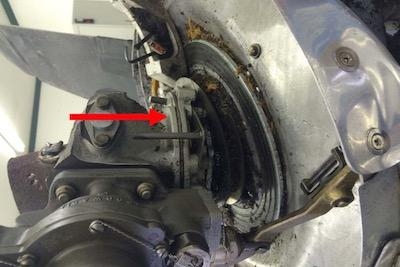Incorrectly Installed Reversing Levers Lead To Fatal Accident
The FAA has issued a Safety Alert for Operators following an accident involving a Beech 1900C powered by Pratt & Whitney PT6A engines.

On February 11, 2015, a Beech 1900C collided with terrain and was destroyed by impact forces and post-crash fire following a loss of propeller thrust during takeoff. The two foreign certificated pilots and two passengers were fatally injured. The flight was a Title 14 of the Code of Federal Regulations part 91 repositioning flight, and was operated by two airline transport pilots (ATP). It was the multiengine turboprop airplane's first flight following replacement of the left engine propeller with an overhauled propeller.
The accident investigation revealed a safety issue concerning the possibility of incorrectly installed reversing levers (beta arms) and related components in PT6A engines. If the beta arm is not installed and positioned such that it is secured under its guide pin, the unsecured linkage could release oil pressure in the beta valve and cause uncommanded travel of the propeller to the feather position. Figure 1 shows examples with correctly and incorrectly positioned beta arms.
The beta arm and guide pin both return to an initial connection and position when the propeller is removed from the engine for an engine inspection or propeller replacement. The airplane maintenance manual contains general warnings about improper adjustment of the beta valve, but no specific warnings about the beta arm-to-guide pin connection and orientation. The Federal Aviation Administration (FAA) found five events in which the incorrect position of the beta arm in a PT6A engine was noted, and these occurred within 100 flight hours after maintenance of the beta arm or related components. The fifth event concluded that the guide pin had been installed backward – as shown in Figure 2 - which enabled the beta arm to free-float, or position itself either above or below the guide pin. The FAA is also aware that one operator welded a tab to the top of the guide pin, making it physically impossible to incorrectly install the beta arm over the guide pin. But the operator notes that this fix would not
prevent an intentional reversal of the guide pin.
Depending on airplane make and model, warnings about this issue in aircraft maintenance manuals vary, ranging from a general warning about the hazards of a misadjusted beta valve assembly, to no warning at all. In March 2016, Pratt & Whitney Canada issued Service Letter PT6A-239R1, “Reversing lever guide pin bracket assembly,” to alert operators about the hazards of incorrectly installing the propeller beta arm. Pratt & Whitney Canada has also revised the PT6A engine maintenance and overhaul manuals, and a current plan for the future is to redesign the guide pin. The FAA and the National Transportation Safety Board (NTSB) are concerned that a propeller on a PT6A engine, that has undergone improper maintenance to the beta valve assembly, could travel uncommanded to the feather position during any phase of flight. Due to the critical function of this assembly, the FAA recommends short-term action to address this safety issue.
The FAA recommends that maintenance personnel and facilities should visually verify, on Pratt & Whitney Canada model PT6A engines, that the propeller-reversing lever, or beta arm, and guide pin are correctly installed and, if necessary, fix any improper installations. Verification should be accomplished during routine scheduled inspections both before and after propeller installation. Appropriately certificated and qualified technicians should perform these actions. These visual inspections should not only detect errors, but also heighten awareness in the maintenance community about the importance of properly installing the beta arm and guide pin.
(Images provided with FAA SAFO. A beta arm guide pin installed backwards. The red arrow points forward, indicating the pin’s
correct orientation)
 ANN's Daily Aero-Term (04.24.24): Runway Lead-in Light System
ANN's Daily Aero-Term (04.24.24): Runway Lead-in Light System ANN's Daily Aero-Linx (04.24.24)
ANN's Daily Aero-Linx (04.24.24) Aero-FAQ: Dave Juwel's Aviation Marketing Stories -- ITBOA BNITBOB
Aero-FAQ: Dave Juwel's Aviation Marketing Stories -- ITBOA BNITBOB Classic Aero-TV: Best Seat in The House -- 'Inside' The AeroShell Aerobatic Team
Classic Aero-TV: Best Seat in The House -- 'Inside' The AeroShell Aerobatic Team Airborne Affordable Flyers 04.18.24: CarbonCub UL, Fisher, Affordable Flyer Expo
Airborne Affordable Flyers 04.18.24: CarbonCub UL, Fisher, Affordable Flyer Expo



